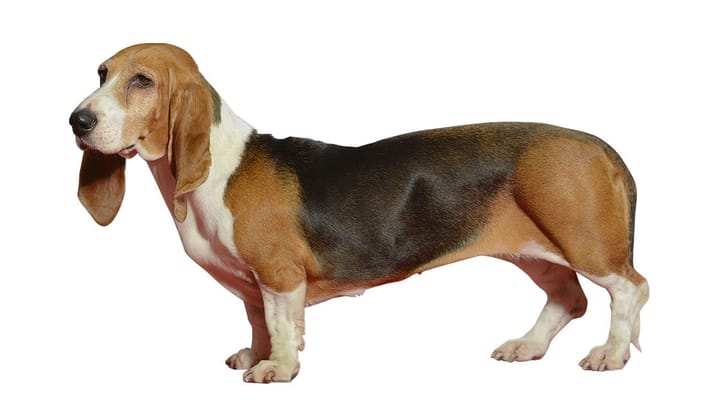Norman Artesien Basset
Other name: Basset Artésien Normand

The Basset Artésien and the Basset Hound are descended from the dwarfed hounds bred in France in the 1800s. The Artésien is lighter-boned than the English Basset Hound but both share striking similarities, and both are bred to hunt small game such as rabbits and hares. The Basset Artésien is not usually seen outside of its native France.
|
Life expectancy |
The Norman Artesien Basset has a life expectancy of between 14 and 16 years |
|
Temperament |
|
|
Size |
Small
|
|
Adult size |
Female
Between 12 and 14 in
Male
Between 12 and 14 in
|
|
Adult weight |
Female
Between 33 and 44 lb
Male
Between 33 and 44 lb
|
|
Coat colour
Often seen of fawn with black and white or just fawn and white. |
Black White Brown |
|
Type of coat
Smooth, short-haired, single coat. |
Short |
|
Eye colour
Dark brown |
Brown
|
To socialise a young Artésien is worthwhile. Dogs that have been introduced to other dogs and other animals are less likely to exhibit behaviour that is antisocial or unwanted.
More details about the Norman Artesien Basset
Norman Artesien Basset: Origins and history
French Bassets diverged at some point shortly after 1870. The two types then most commonplace were the Basset Artésien Normand and the Basset d'Artois. Both of these dogs continued to be bred to assist hunters. Due to its short stature the Basset Artésien was able to follow small game through burrows.
Physical characteristics of the Norman Artesien Basset
A small, dwarfed dog with a long body and short legs. The head is noticeably domed and the muzzle broad and of a medium length. The eyes are large and expressive and the ears large and very long, hanging close to the cheeks and shaped in a ‘corkscrew’ manner. The tail of the active dog is carried out and upwards.
FCI classification of the Norman Artesien Basset
-
Group 6 - Scent hounds and related breeds
-
Section 1 : Scent hounds
Norman Artesien Basset: Characteristics
Norman Artesien Basset: Behaviour
Training a Norman Artesien Basset
To train the Basset Artésien requires the owner to deliver consistent and confident training. This is a dog that is easily distracted and quick to boredom.
Norman Artesien Basset: Lifestyle
Breed compatibility Norman Artesien Basset
Norman Artesien Basset: Purchase price
We do not have enough data to set an average price for an Old Danish Pointing dog. You’re also looking at between £170 to £185 per month to care for this dog.
Norman Artesien Basset: Shedding
Average
The Artésien sheds a lot and its hairs are hard to remove from upholstery and clothing.
Norman Artesien Basset: Grooming
This dog's fur must be brushed with a rubber brush to remove dead hair. The claws must be kept short and the ears checked regularly for signs of an infection or a build-up of wax.
Norman Artesien Basset: Health
14 to 16 years
This is an active and courageous dog that likes nothing better than a day of outdoor exploration.
The Basset Artésien is not especially tolerant of hot temperatures and is prone to heat stroke. Special care must be taken of the Basset Artésien during the summer months.
The Basset Artésien is very tolerant of cold temperatures.
The Basset Artésien is more prone to weight gain than most. If your dog is not exercised as regularly as it should be and is fed too much human or substandard food it will quickly become obese.
- Intervertebral Disc Disease
- Hip Dysplasia
- Entropion/Ectropion
- Skin Problems
- Ear Infections
Do you want a Norman Artesien Basset dog ?
Oh no...
There are no Norman Artesien Basset adoption profiles at the moment...


